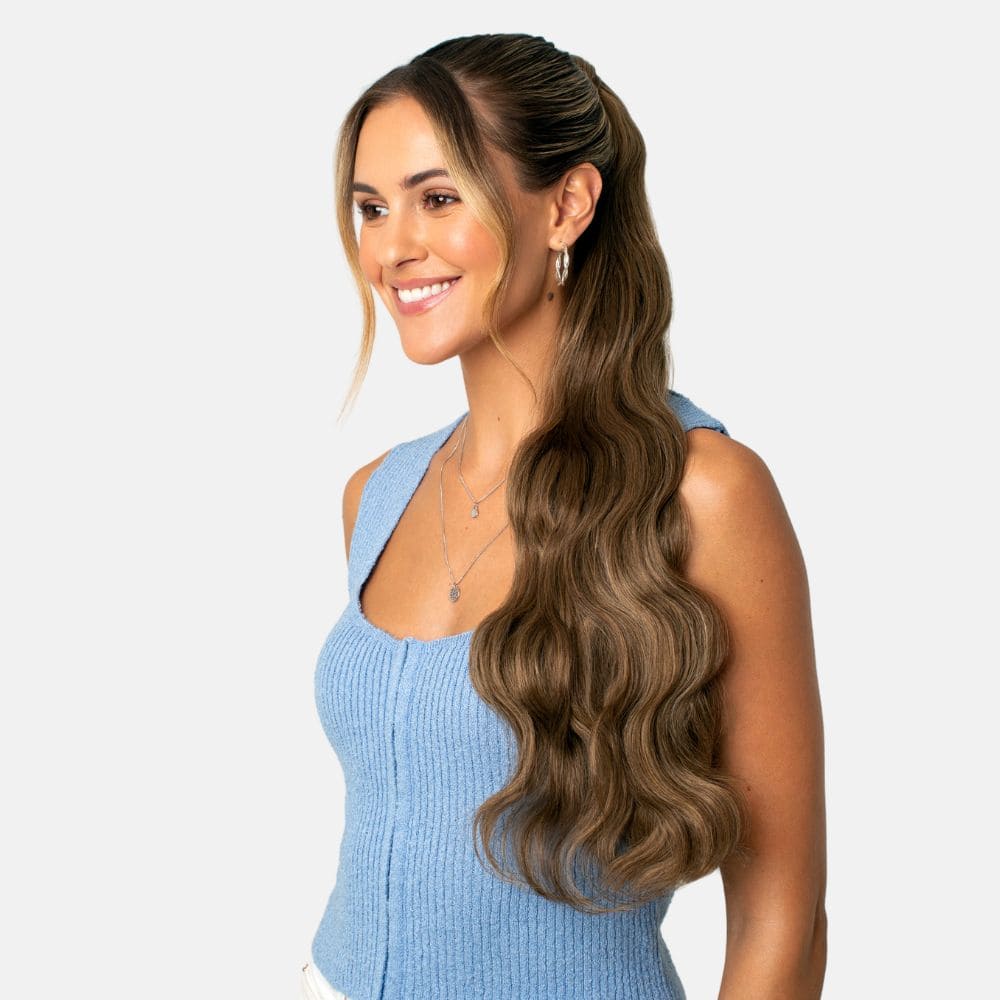For many women, changing hair colour can be a transformative experience—whether it’s lightening up after years of brunette shades, adding dimension with highlights, or embracing vibrant colours like reds or pastels. But achieving the perfect shade while keeping hair healthy is often more complex than it seems.
We spoke to Charlotte Quinn; an experienced hair colourist and Wella Trend Vision finalist, to explore what you need to know before taking the plunge into a major colour shift, from how long it realistically takes and what to expect.

Q: How long does it realistically take to achieve a major colour shift, like going from brunette to blonde, without damaging the hair?
Charlotte: “Achieving a significant colour shift from dark to light while maintaining hair health typically takes up to 12 months, with appointments every 8–12 weeks. This gradual approach helps protect the integrity of the hair.”
Since the process can take longer than some women might expect, clip-in hair extensions offer a great way to add temporary colour while you work towards your desired shade. They not only provide instant results but also allow you to experiment with different tones and textures without the commitment or risk of damage.

Caitlin chose to wear a One Piece Flicky to enhance her dark hair, and the Bounce Wrap Ponytail to enhance her blonde hair. Clip-ins are an excellent option for those looking to blend their natural hair with their new colour as it evolves, giving a seamless, salon-worthy look in the meantime. Additionally, they can boost volume and thickness, enhancing the overall transformation during the process.
Q: What should someone expect in terms of hair condition during and after a major colour shift?
Charlotte: “Hair conditions will vary based on texture. Even with protective treatments like Olaplex, lightening can alter the hair’s structure. Fine hair may feel slightly thicker but stretchier, while coarse hair can become drier, more prone to tangling, and harder to manage.”
When considering a hair colour change, especially a permanent one, it’s important to think about the potential impact on your hair’s health. Long-term, intense colouring can significantly affect hair condition. Clip-in hair extensions provide a low-commitment, damage-free way to add colour without the cost and potential risks associated with frequent colouring.
Q: Are there certain hair types or starting conditions where you would advise against a drastic colour change?
Charlotte: “Yes. We recommend avoiding major colour changes for clients with a history of chemical treatments like perms or relaxers, or those with excessive heat or chemical damage, very fragile or coarse hair, or certain medical conditions or treatments. If the hair condition won’t support the goal, a less drastic approach is better.”
Before beginning a major colour shift, we recommend having a professional assess your hair’s condition. Understanding the potential effects on your hair’s health is essential before committing to any changes. For those who may not be the ideal candidates for a drastic colour change—whether due to hair health concerns, previous chemical treatments, or simply a fear of commitment—clip-in hair extensions offer a perfect alternative. These extensions allow you to experiment with new shades and styles without the risk of damage or the long-term commitment of permanent colour. They’re a great way to achieve the look you want, whether it's adding highlights, going lighter, or trying out bold colours, all while keeping your natural hair healthy and intact. The below image shows how the shade 8/10 Baby Bronde was used to enhance the lighter ends of Gabrielle’s hair.

Q: What colour techniques do you recommend for someone wanting to go lighter without achieving their ideal shade in one session?
Charlotte: “We suggest a highlight and tone or blend session. This approach gradually lightens the hair, working with the underlying pigments to ensure a natural look and a healthy lightening process.”
When it comes to toning, it’s important to remember that human hair extensions can also be toned to match your desired shade. If you’re gradually lightening your natural hair, toning your extensions to blend seamlessly with the process can help create a cohesive look. Toning extensions allow you to balance out any brassiness and achieve cooler or warmer tones depending on your needs. Just like natural hair, extensions require proper care and maintenance to ensure the tone stays vibrant and fresh. Regular touch-ups will help keep both your hair and extensions looking flawless as you work towards your ideal colour.
Q: How can someone keep their hair looking natural and healthy during a major colour change?
Charlotte: “Consistent use of professional-grade products and a weekly home care routine is essential. Bond builders in every colouring session and small steps, like combing conditioner through the hair in the shower, can make a significant difference in maintaining hair health.”

Protective hairstyles can be used to support your hair during this transition, we recommend wearing loose braids, buns, or twists, which not only provide a simple-to-do hairstyle but also help preserve hair integrity by reducing stress on your strands and promoting healthier growth as your colour change progresses.
Top Tip: Show your hair some love by regularly combing through a high-quality leave-in conditioner each week. This helps restore much-needed moisture, especially during your colouring journey when your hair may be more prone to dryness. Keeping your hair nourished ensures it stays healthy, shiny, and resilient throughout the transformation process.
Q: What are common misconceptions clients have about making a major colour change?
Charlotte: “Many clients think that stripping colour will restore their natural shade. In reality, stripping colour takes hair through a series of undertones—reds, oranges, yellows—depending on the lighting process. Natural colour can only be achieved by growing it out.”
If you’re looking to restore your natural hair colour, this can also be a timely process, and the key is to be patient. Just like when lightening or changing your colour, regrowing or restoring your natural shade requires a gentle, gradual approach to avoid damaging your hair. During this time, clip-in hair extensions can be a great way to temporarily enhance your look, allowing you to enjoy fuller, longer hair without compromising your restoration efforts. Whether you’re blending in new growth or simply adding volume while your hair recovers, clip-ins offer a seamless solution to help you feel confident throughout the process.
If you need to darken the roots of your hair extensions to help blend with your regrowth, this can be done by using a wash-out root touch-up spray. These temporary colouring products will wash out on the next shampoo and should not cause any damage to the extensions, however, we would recommend doing a patch test to be confident in the outcome.

Q: How do you determine the right shade for someone going against their natural colour?
Charlotte: “We consider factors like skin tone, eye colour, lifestyle, and maintenance commitment. Generally, we avoid taking someone more than 3–4 shades lighter or darker than their natural colour.”
When you're looking to explore a new shade that contrasts with your natural colour, clip-in hair extensions can be a fantastic way to try out different tones without the long-term commitment. Look for brands which offer a colour-matching service or colour samples to help you find a perfect blend.

Since clip-ins are available in a wide range of shades, they can allow you to experiment with lighter or darker colours that complement your natural hair. You can match them to your skin tone and eye colour while testing out the look.
Q: What should someone know about maintaining vibrant colours like red, plum or fashion shades (pastel, vivid colours)?
Charlotte: “Vibrant colours require regular maintenance, as strong pigments can fade quickly—even after one wash. Using colour-depositing masks, washing with cooler water, and reducing wash frequency helps maintain the colour longer. Expect some colour change after each wash or when using heat tools, as heat can also strip the pigment.”
Stranded customer Shona uses shade 118 Cherry Blossom in the Wandwave Ponytail to enhance her vibrant cherry hair colour.

Q: How can someone prepare their hair for a major colour change?
Charlotte: “Swap supermarket products for professional shampoos, conditioners, heat protectants, and hair masks. Use a clarifying shampoo and nourishing mask beforehand to remove buildup and condition the hair. A fresh trim before colouring also supports healthy results.”
Q: How often will touch-ups or refreshes be needed after a dramatic colour change?
Charlotte: “ Maintenance depends on the shade and goal. For vibrant colours, toners often need refreshing every 8–12 weeks. Full-colour maintenance may be needed every 6–12 months, though ongoing lighting goals may require a full-service repeat every 12 weeks, based on hair health.”
The great news is that clip-in hair extensions require minimal maintenance to keep their colour vibrant. Since they're only worn occasionally and washed sparingly, they don’t fade as permanent colour does. This makes it easy to maintain the shade of your clip-in extensions for a long time without needing frequent touch-ups.
Q: How to correct a bad hair colour job?
Charlotte: “Correcting a bad hair colour can be tricky, and the solution depends on what specifically went wrong. The best first step is to consult a professional colourist who specialises in colour correction. They’ll understand colour placement, undertones, pigments, and the techniques to neutralise unwanted tones. If a trip to the salon isn’t an option, a general guideline is to go darker to cover issues. For example, if a blonde colour job turned out patchy or brassy, toning it down with a darker blonde or light brown might help. For brunette colours that look uneven or too light, going a shade or two darker can blend and smooth the overall look. Remember, self-correction can be challenging, so when possible, professional help is often the safest route.”

Q: What is the hardest hair colour to change?
Charlotte: “The most difficult colour to correct is black, especially if it’s from a build-up of box dye. Lightening black hair can be risky, with potential chemical reactions, metallic salts in the dye, and unpredictable results. Bleached, white, or over-processed hair is also challenging to correct because it’s often fragile and prone to breakage. In both cases, achieving the desired colour safely and maintaining the health of your hair can require multiple sessions with a professional.”
Changing your hair colour, whether it's a major shift like going from brunette to blonde or simply refreshing your natural shade, is a process that takes time and careful consideration. Experts like Charlotte emphasise the importance of gradual colour transitions, typically spanning 12 months, to ensure the health and integrity of your hair. Factors such as skin tone, eye colour, and lifestyle are all considered when determining the right shade to avoid dramatic differences that could lead to hair damage or frequent touch-ups. Patience is key, but with the right approach, you can achieve a stunning transformation.
Conclusion:
If you're hesitant about making a drastic change all at once or want to add more volume to enhance your new look, clip-in hair extensions can be a perfect companion to your colour journey. While achieving a colour change can be costly and require ongoing upkeep, clip-in hair extensions offer an affordable, low-maintenance way to support your colour transition.
Clip-ins allow you to experiment with new tones and shades that complement your natural hair, giving you the flexibility to adjust your look without the commitment of permanent colour changes. By building a collection of clip-in extensions in varied shades, you can easily match your evolving colour, and keep your hair feeling fresh and exciting. Whether you’re transitioning to a lighter or darker shade, clip-ins are a versatile solution to enhance your style and keep you from getting bored with your hair colour while protecting your natural strands during the process.











































